Could Pabst Brewery Transform Industry?
CEO sees new Milwaukee brewery as place for innovative creations.
Wednesday April 12th, 2017 will go down in local history as the day the Los Angeles-based Pabst Brewery returned to the roots it set down in Milwaukee in 1844. At a ceremony held in its new facilities located in the former First German Methodist Church, 1037 W. Juneau Ave., key personnel of the brewery, including owner and Chairman Eugene Kashper, CEO Simon Thorpe, and others spoke with enthusiasm about the new 4,000 barrel annual capacity brewery located on the grounds of the former Pabst brewery, once the nation’s largest. Pabst, under previous ownership, abruptly shuttered the plant in 1996. Wednesday was the first time that Pabst beers, brewed on the site, had been tapped since. The official opening is Friday — increasingly known as Milwaukee Day, since it falls on 4/14, the city’s area code, with a grand opening block party scheduled for Saturday, May 13, 1-7 p.m.
Nobody spoke with more enthusiasm about the project than Rebecca Berkshire, a Milwaukee native and 20-year veteran of the hospitality industry who will be running the front-of-house operations. She got a laugh out of the non-Wisconsinites in the crowd when she spoke feelingly of her childhood adventures going out to taverns with her folks and grandparents. Although this is a cultural norm in Milwaukee, it apparently is one that has not traveled to the West Coast.
The Pabst management began the event promptly at 12:30 p.m. in the second-floor tasting room, a light and airy space of unmistakable ecclesiastic origin. However, its use as a church is long in the past. The 1873 building was bought by the brewery in 1896 and turned into a hospitality center called the Forst-Keller. Pabst announced plans to renovate the building two years ago.
No Longer A “Virtual” Brewery
Kashper and his equity partners bought Pabst in September, 2014. At the time he said: “Pabst Blue Ribbon is the quintessential American brand – it represents individualism, egalitarianism, and freedom of expression – all the things that make this country great. The opportunity to work with the company’s treasure trove of iconic brands, some of which I started my career selling, is a dream come true.”
Today, Pabst is the largest privately owned American brewery. Yet, despite its six million barrel annual sales, all brewing has been done under contract at 15 locations in the U.S., including the Miller Brewery in Milwaukee.
Kashper wanted his own brewery, and decided to locate it in Milwaukee, on the very ground where Pabst had been brewed for so many years. The purpose of the new facility was not to ease Pabst’s dependence on other brewers — at 4,000 barrels a year it would make little dent — but rather to “serve as Pabst’s hub for innovation and new product ideas and [to] develop the next generation of great beers in the Pabst family,” according to a statement.
This is a reasonable goal, for in addition to the flagship Pabst Blue Ribbon Beer, Kashper owns the name and formulae for some 70 brands — some are Pabst labels, like Andeker and Old Tankard Ale — and others are brands acquired by previous owners including Stroh’s, Ballantine, Lone Star, G. Heilman and even Schlitz, the beer that made Milwaukee famous. These assets did not come cheap. Some reports say Kashper paid $700 million for his virtual brewery, so it is natural that he would like to get his money out of the dormant assets.
Kashper served as CEO until December 2016 when he hired Thorpe, a native of the United Kingdom, to take the job, while Kashper remained as chairman. This freed him to concentrate on long-term planning and other complexities of running a brewery with 500 distributors and 15 producers. One thing that is occupying his time is an open suit filed in 2016 in Milwaukee County Circuit Court accusing Miller Coors of bad faith in the cancellation of a long-term contract to brew Pabst products in Eden, N.C.
New Generation Brings Change to Craft Beers
“This is the first true innovation brewery for us,” CEO Thorpe told Urban Milwaukee. “It allows us to do an awful lot of things that we haven’t been able to do.
“There is a new generation of craft brewers coming out. Younger brewers are thinking differently about craft, and that is where we want to play. We do not want this to be a museum,” he said, looking around the high-ceilinged room flooded with light from its Gothic windows.
“Craft is a crowded place,” he said, referring to the hyper-stimulated market, and the profusion of new beers, some seemingly designed merely to take shelf space away from competitors until a new trend rolls along.
Budweiser has rolled out a number of fruit-flavored beers like Cran-Beer-Rita, Lime-A-Rita, Straw-Ber-Rita, Mango-Rita and other atrocities in an attempt to capture a niche market that one is surprised to know exists. (Apparently it is women with indifferent taste buds.)
Thorpe scoffs at such products, saying “there is a difference between brewing something and adding things to it.” Thorpe says he wants to focus on “the heritage of brewing things instead of adding adjuncts and flavorings to beer.”
The Master Brewer’s Challenge
Gregory Deuhs is the Master Brewer for Pabst, and the recipient of the 2016 Large Company Brewer of the Year from the Great American Beer Festival. He is based in Milwaukee.
Deuhs says “this craft brewery will serve as an innovation laboratory for Pabst to experiment with new craft brews and resurrect some classics from the Pabst archives.”
He has already done so for Ballantine Ale, regionally popular on the East Coast. Duehs also revived Old Tankard Ale, a Pabst brand that historically had been popular in Milwaukee. One of the challenges Duehs faces is how to recreate a beer that had not been produced for decades.
“Old Tankard Ale is a 1937 recipe,” he says. He had to scare up the contemporary equivalents of a post-Prohibition grain bill. Other heritage brands may rely on hop, malt or yeast varieties that are no longer produced in sufficient quantities to meet the production required. This is no field for amateurs.
One of the first beers Duehs resurrected was Andeker, which was long the premium Pabst product. The beer is fondly remembered by Milwaukeeans over 50, and utterly unknown to the much larger younger demographic that constitutes the majority of beer purchasers.
So much for the heritage beers, including Schlitz, which was re-released with its original formula some years ago. (It may wound local pride to learn the beer that made Milwaukee famous doesn’t sell particularly well anywhere else.)
Duehs instead wants to concentrate on the experimental and innovative. Pabst has taken up the banner of sustainability and local sourcing, he says.
“We’re using a local yeast factory in West Allis, and using a special malt company. We want to team up with new hop farms in Wisconsin, Michigan and the Midwest,” he says. We want to team up with world class breweries, borrow yeast strains and brewing techniques from them.”
Duehs says he wants to cooperate with other brewers in the area. “If they want us to take a look at a sample in our lab, we will,” he said.
Duehs collaborates with John Kimes, the head brewer of the Milwaukee facility. Kimes is eager to “brew avant-garde, innovative beers including traditional craft styles with a twist,” he says.
One example of a traditional craft style with a twist is Noreastie Boys “Northeast” IPA, which is billed a the “First in Pabst World IPA Series.” Samples of the beer were poured for the attendees of the opening ceremonies, along with an unfiltered, unpasteurized “Zwickel Keller” German Lager, named for the building in which it was brewed. It has a special yeast strain which was quite evident on the palate.
The Opening Ceremonies
The events Tuesday included a media event at 12:30 p.m. featuring beer samples and words of introduction, along with a chance to meet the principals, who mingled freely with the guests. The ceremonies and attendant details were handled by Boelter + Lincoln, and flowed as smoothly as a gravity-fed tap line. Guests were treated to a sandwich board including liverwurst and Wisconsin cheeses. The brewery intends to operate as a high-end gastropub, with locally sourced products. It’s off to a good start.
Later in the evening, around 6 p.m., the building got rededicated again in a ceremony with Mayor Tom Barrett and County Executive Chris Abele and the Pabst dignitaries. This took place out of doors, where the Californians, dressed for a blizzard, and shivering in the 50 degree air, were conspicuous amongst the mostly Milwaukee members, who were dressed as if for a day in the park as they marvelled about the salubriousness of the weather, now that Spring has arrived.
The dignitaries gathered around the simple props, including a mallet, a couple of pint glasses and a ceremonial firkin of beer, which was tapped by head brewer Kimes, a powerfully built fellow.
Barrett was particularly happy to see the final building in the complex fully renovated and operational, recalling the dark days in 1996 when he was a member of Congress and the brewery closed. Barrett, who worked his way through college selling beer at County Stadium, clearly took personal satisfaction in seeing the old brewery running again.
Afterwards, the building opened for a reservation-only dinner attended by a number of local luminaries, including Scott Johnson, Leslie Montemurro and Mike Eitel, who had once entertained thoughts of opening a place in this building. Members of New Age Narcissism, the featured band of the upcoming Pabst Street party May 13th, were also present, as was Jim Klisch of Lakefront Brewery.
Also in attendance was Karen Haertel, whose husband Jim Haertel kick-started the revival of the site when he bought an option for the brewery property in 2001. Haertel now operates the Best Place at the Pabst Brewery, just a block to the east. He was visiting his brother on an annual trip, Karen Haertel said.
Also invited but not in attendance were Russ Klisch of Lakefront Brewery, and Jim McCabe, who is building his own 100,000-barrel MKE brewery at the former Pabst distribution center down the block. Both were in the District of Columbia attending the Brewers Association Craft Brewers Conference.
Interestingly, the new Pabst facility does not include a gift shop, which is a usual trapping of such a facility. However, abundant Pabst memorabilia is available at the Best Place gift shop.
Photos from the Event
Out on the Town
Kashper and company have been out on the town during their visit to Milwaukee. Once the topic of Andeker came up, I asked if Kashper or CEO Thorpe had visited the Swingin’ Door Exchange. Both smiled and nodded assent. The downtown tavern has a wooden, carved Andeker barrel hanging above the bar, secured by chains to the ceiling. You bet they’ve been there. The Door is known for its 3-for-$5 Pabst pricing, and sells an enormous volume.
Kashper also admitted to a familiarity with Lakefront Brewery. “I wanted to check the place out Tuesday, and we were hungry. We got there at 8 p.m. and were told it was too late, that the restaurant was closed,” Kashper said. “We’re going to keep this place open late,” he added, referring to his new brewery.
Jim Klisch, who had heard that his crew unwittingly threw out the owner of Pabst the night before, made certain that Kashper had his business card and an invitation to drop by whenever he would like.
Eight Different Brewing Lines
The Pabst Brewery will have up to eight brewing lines going at a time, a company press release noted. Initial brews offered at the brewery will include:
- Bier de Mars (March Beer: Northern French Bier de Garde)
- Forst-Keller (Zwickel Keller, German Lager)
- 11th Street Dark Wheat (Dunkelweisse)
- Not a Kid Anymore (Maibock)
- Sticky Fingers Honey Wheat (American Wheat)
- Van Damme Good Tripel (Belgian Tripel)
- Noreastie Boys “Northeast” IPA – First in Pabst World IPA Series
- Pabst Andeker (Munich Helles first brewed by Pabst in the 1950s)
- Old Tankard Ale (American Ale first brewed by Pabst in the 1930s)
- Cream City (Oatmeal Stout)
New Pabst Brewery
Political Contributions Tracker
Displaying political contributions between people mentioned in this story. Learn more.
- December 1, 2020 - Tom Barrett received $250 from Russ Klisch
- June 25, 2018 - Tom Barrett received $220 from Russ Klisch
- June 21, 2017 - Tom Barrett received $400 from Russ Klisch


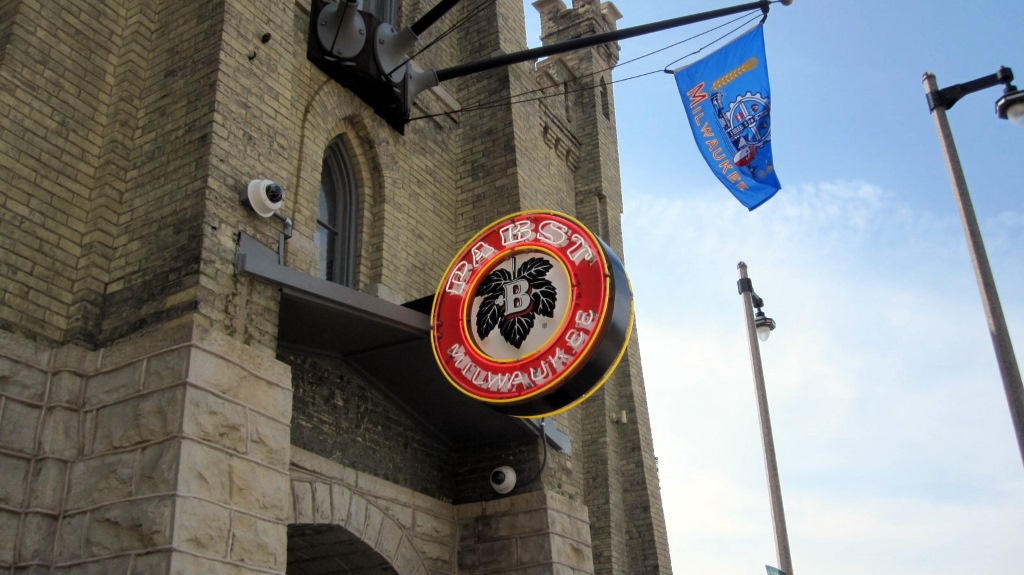

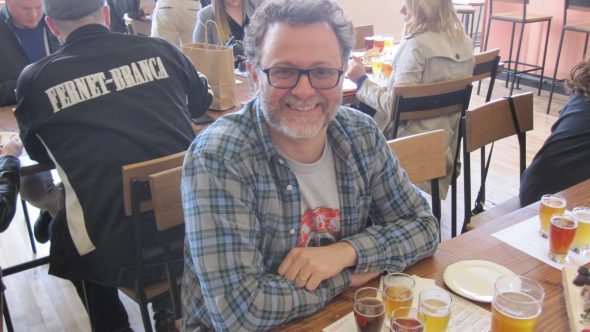
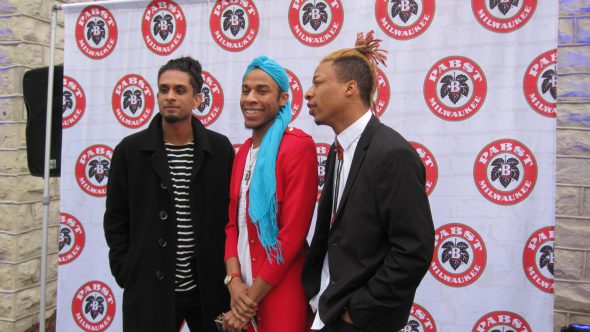
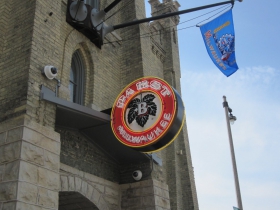
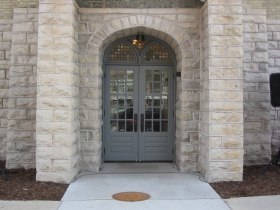
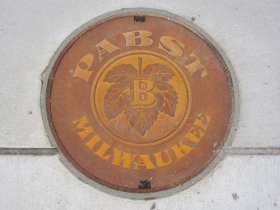
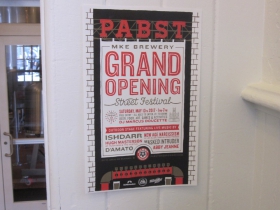
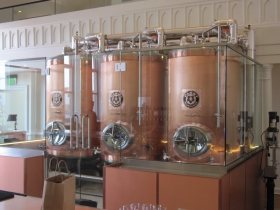
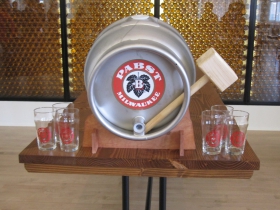
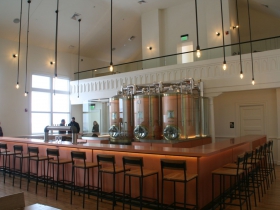
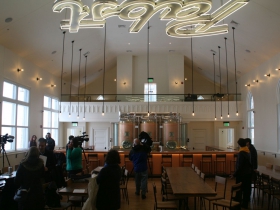
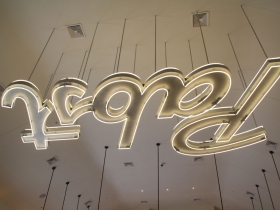
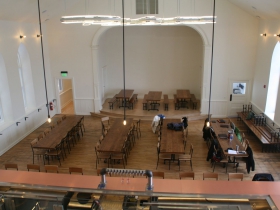
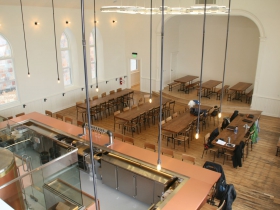
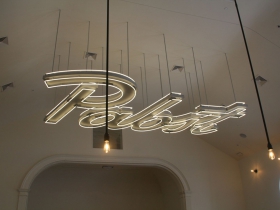




















Here’s a little more information about the Ballentine brand garnered from the Pabst web page:
” In 2014, Pabst relaunched the 136-year old Ballantine India Pale Ale. First brewed in America in 1878, Ballantine IPA was a beer for connoisseurs. It has been credited as an inspirational influence for the present day American craft beer revolution. Handcrafted by Pabst’s master brewers, this delightfully hoppy brew resurrects its deep heritage and storied past to embody an IPA worthy of the original Ballantine name.
Ballantine XXX Ale also still proudly displays its three interlocking rings and can be found throughout the Northeast.”
In the 70’s, several of us would frequently have lunch at Becker’s Bar on 10th and Highland. We washed down Peter Becker’s chili with Ballentine’s IPA.
I was a member of the Milwaukee Liederkranz, a men’s singing society, for 30 years. For our 125th Anniversary in 2003 I was the historian of the group.
The Forst Keller was used as the Liederkranz clubhouse from 1925 to 1934. They rehearsed in the upstairs church space and then came downstairs into the Forst Keller restaurant for a bit of beer. The Liederkranz had 90 active singers at that time and 450 passive members. The passive members were important Milwaukee leaders who kept the beer flowing during Prohibition. The Liederkranz even sponsored train trips to resorts up north with beer on the train during this time.
The Pabst Brewery needed the upstairs hall for office expansion after Prohibition so the Liederkranz moved their clubhouse to 779 Front St, where they remained till 1945. This is the current site of the Safe House.
The Liederkranz used the Pabst facility again as a clubhouse from 1945 to 1975. I had an old friend, now gone, who told me of the wonderful times he had, singing upstairs, and then going downstairs to the Forst Keller to continue singing for the restaurant patrons. He was a bachelor at that time so it was fun time for him. The Binder family ran the restaurant for much of that time.
According to your article, Pabst could indeed transform brewing! Thanks, Michael Horne – reading your words I felt like I was there at the ceremony!
This sounds great!
My dad is nearly 80yo now, and was a Milwaukee cop for years. He drank Miller because my aunt worked at the brewery and she got a couple cases of “not quite full” bottles (or something like that) every payday–which she promptly gave to my dad.
We were very South Side working class, but I remember dad really being impressed with Andeker and drinking it on special occasions.
In the summer of 1966 I worked at Chief Oshkosh Brewery in Oshkosh, of course. We could buy short fill cases of beer for $1.50. There also was an old cooler of short fill beer in the lunch/break room where you could get a beer anytime during the working day.
Short fills were in returnable bottles and they had a detector on the bottling line or maybe just a guy watching beer bottles going by.
Chief was on its last legs at that time and everything was done by hand. Cases were filled by a guy sitting at a machine where you put a clean empty case on a platform, you pushed a foot button, the platform raised, 24 bottles of beer dropped in, platform dropped down, you shoved the case to the right where there was another guy loading cases on pallets.
The free beer was the best in the kegging room. This beer was fresh, unpasturized, and at a 34 degree temperature.
Is Pabst opening the old Miller Coors brewery in Eden,NC in October 2017?
Is Pabst opening the old Miller Coors plant in Eden,NC